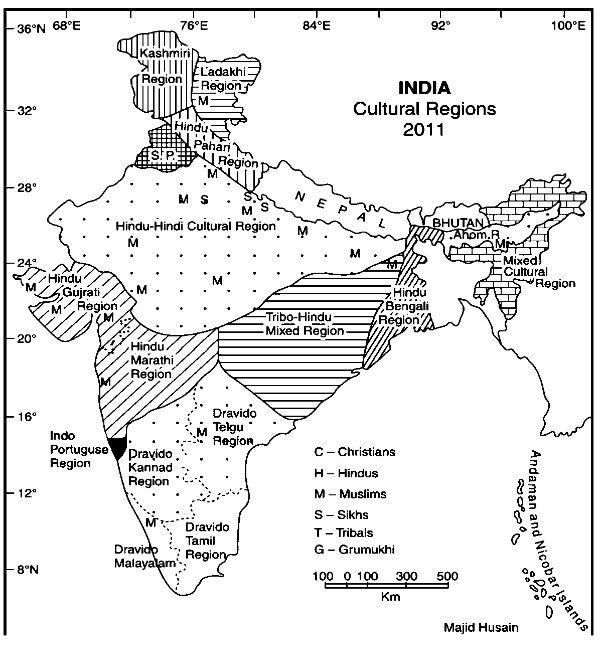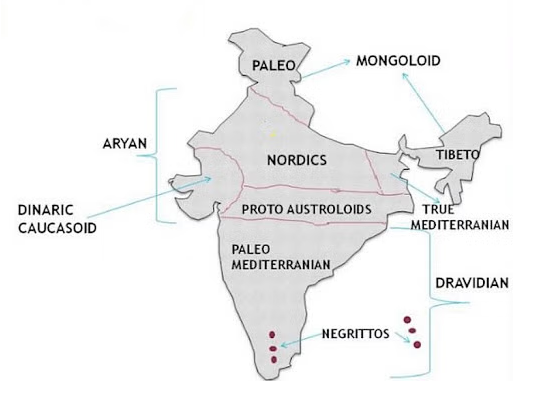Culture is essentially the embodiment of a way of life, shaped by various factors such as geographical topography, climate, ethnicity, and language. This way of life encompasses both materialistic and non-materialistic aspects.
The materialistic facets of culture involve essentials like food, clothing, and housing. On the other hand, the non-materialistic aspects include belief systems, values, language, songs, festivals, and music.
Cultural regions, in turn, refer to geographical areas that exhibit homogeneity in their way of life.
Globally, some major cultural regions include Western Culture (Occidental or European Culture), Anglo-American Culture, Slavic Culture (Russian culture), Latin American Culture, Islamic Culture regions, Sub Saharan African, Australia-European cultural region, Southeast Asian Cultural region, Sino-Japanese cultural region, and Indic or Indian culture (Hindu Culture region).
Delving deeper into Indian culture regions, they are further divided into distinct parts, each characterized by unique cultural nuances:
- North Indian Cultural region or Aryan Cultural region
- Kashmiri cultural region
- Ladakhi cultural region
- The Hindu Pahari culture region comprising Himachal Pradesh and Uttarakhand
- Sikh-Punjabi Cultural region
- Rajasthani culture
- Gujarati culture
- Marathi culture
- Hindu-Hindi cultural region (Haryana-UP-Bihar-MP)
- Hindu tribal culture (Chhota Nagpur region)
- Bengali culture
- North Eastern Cultural or Tribal Culture
- Buddhist Sikkim culture
- Ahoms culture
- Garo-Khasi culture
- Naga culture
- Mix culture region
- South Indian Cultural region or Dravidian cultural region
- Indo-Portuguese culture
- Kannad Dravidian culture
- Malayalam culture
- Tamil Dravidian culture
RACES OF INDIA
- India's racial composition comprises groups originating from various parts of the world.
- The Negritos, Western Brachycephals, Proto-Australoids, Mongoloids, and Mediterraneans represent the five prevailing racial categories within the Indian subcontinent.
- Over time, individuals from across the globe arrived in India through diverse land and ocean routes.
- This has rendered India a melting pot for nearly all major world races, contributing to its ethnic blend being characterized as "diverse and diversified."
India boasts a diverse array of racial groups, each distinguished by physical attributes such as skin color, hair color, jaw structure, and eye structure.
- The concept of race is intricately tied to an individual's biological characteristics, encompassing both physical and genetic features.
- Consequently, India is recognized for its extensive and varied ethnic composition, hosting representatives from nearly all major races worldwide.
The rich tapestry of India's racial diversity is a result of:
- Historical and contemporary waves of migration, shaping the country's demographic landscape.
- Societal evolution, influenced by internal and external factors, has played a pivotal role in defining the multitude of races coexisting within the nation.
- Intermarriages across different racial stocks further complicate the determination of individual racial origins, presenting a complex challenge for scholars and researchers.
- A noteworthy attempt at categorizing India's population into racial groups was made during the 1891 Census operations by Sir Herbert Hope Risley.
- His classification included types such as Mongolo-Dravidian, Mongoloid, Turko-Iranian, Indo-Aryan, Scytho-Dravidian, Aryo-Dravidian, Mongoloid, and Dravidian.
- However, this categorization faced criticism, particularly for combining linguistic (Aryan and Dravidian) and racial characteristics.
In 1931, B.S. Guha conducted anthropometric measurements across various regions during the Census, identifying six primary races with nine subtypes. While the actual prevalence of these groups in Indian society remains challenging to ascertain, this classification persists, underscoring the multi-racial nature of the country's population. India stands as a testament to the coexistence of individuals from diverse racial backgrounds, contributing to its identity as a truly multi-racial nation.
TRIBE
A tribe is a social division within a traditional society, comprising households connected by common culture and dialect through social, financial, religious, or blood ties. Tribes exhibit unique qualities and characteristics, rendering them distinct cultural, social, and political entities.
- The distinction between race and ethnicity lies in the small genetic variations across the globe due to geographical diversity.
- Race pertains to biological features such as skin color, eye shading, facial structure, etc. Ethnicity, on the other hand, encompasses cultural factors like nationality, regional culture, ancestry, and language.
- India, often described as a "melting pot," harbors a vast and diverse tribal population, with approximately 104 million individuals, constituting 8.6% of the total population.
- Madhya Pradesh holds the largest tribal population (15.3 million or 21%), while Lakshadweep has the highest tribal population percentage (94.8%).
- The Constitution recognizes tribal communities under 'Schedule 5,' designating them as 'Scheduled Tribes' (STs).
- The National Commission for Scheduled Tribes (NCST) was established to safeguard their interests.
The Tribal Sub Plan (TSP) strategy focuses on the socio-economic development of tribal people, ensuring non-divertible and non-lapsable funds.
Particularly Vulnerable Tribal Groups (PVTGs) are more vulnerable among tribal groups, residing in remote areas with poor infrastructure. The Ministry of Tribal Affairs and the NCST play crucial roles in their development.
The Denotified tribes, once labeled as criminals under the Criminal Tribes Act 1871, continue to face challenges, and efforts are made for their inclusive development.
The Idate Commission advocated the repeal of the Habitual Offenders Act. Various schemes, such as the Jiban Sampark Project in Odisha, aim to empower PVTGs.
The classification of tribes in different states includes diverse groups with unique identities and cultures, contributing to India's rich cultural tapestry. The government, through various commissions and ministries, works toward the comprehensive development of tribal communities, emphasizing inclusivity and socio-economic progress.
| **State/UT** | Tribes** |
| Andhra Pradesh |
Andh, Sadhu Andh, Bhil, Bhaghata, Dhulia,rona, Kolam, Gond,Thoti, Goundu, Kammara, Savaras, Dabba Yerukula, Sugalis, Nakkala, Pardhan, Gadabas, Chenchus (Chenchawar), Kattunayakan, Jatapus, Manna Dhora | |
| Arunachal Pradesh | Singpho, Monpa, Abor, Sherdukpen, Galo, Apatanis |
| Assam | Khasis, Chakma, Dimasa, Gangte, Garos, Hajong, Chutiya |
| Bihar | Gond, Birjia, Asur, Savar, Parhaiya, Chero, Birhor, Santhals, Baiga |
| Chhattisgarh | Nagasia, Biar, Khond, Agariya, Bhattra, Mawasi, Bhaina |
| Goa | Varli, Dubia, Siddi, Dhodia, Naikda |
| Gujarat | Patelia, Bhil, Dhodia, Bamcha, Barda, Paradhi, Charan, Gamta |
| Himachal Pradesh | Swangal, Gujjars, Lahaulas, Khas, Pangwala, Lamba, Gaddis |
| Jammu and Kashmir | Balti, Garra, Sippi, Bakarwal, Mon, Gaddi, Purigpa, Beda |
| Jharkhand | Gonds, Birhors, Savar, Mundas, Santhals, Khaira, Bhumji |
| Karnataka | Gond, Patelia, Barda, Yerava, Bhil, Koraga, Adiyan, Iruliga |
| Kerala | Malai, Aarayan, Arandan, Uralis, Kurumbas, Arandan, Eranvallan |
| Madhya Pradesh | Kharia, Bhils, Murias, Birhors, Baigas, Katkari, Kol, Bharia, Khond |
| Maharashtra | Warlis, Khond, Bhaina, Katkari, Bhunjia, Rathawa, Dhodia |
| Manipur | Thadou, Aimol, Maram, Paite, Chiru, Purum, Kuki, Monsang, Angami |
| Meghalaya | Pawai, Chakma, Raba, Hajong, Lakher, Garos, Jaintias, Khasis |
| Mizoram | Dimasa, Raba, Chakma, Lakher, Khasi, Synteng, Kuki, Pawai |
| Nagaland | Nagas, Angami, Sema, Garo, Kuki, Kachari, Mikir, Konyak, Lotha |
| Odisha | Gadaba, Ghara, Kharia, Khond, Matya, Oraons, Rajuar, Santhals |
| Rajasthan | Bhils, Damaria, Dhanka, Meenas(Minas), Patelia, Sahariya |
| Sikkim | Bhutia, Khas, Lepchas |
| Tamil Nadu | Adiyan, Aranadan, Eravallan, Irular, Kadar, Kanikar, Kotas, Todas |
| Telangana | Chenchus |
| Tripura | Bhil, Bhutia, Chaimal, Chakma, Halam, Khasia, Lushai, Mizel, Namte |
| Uttarakhand | Bhotia, Buksa, Jaunsari, Raji, Tharu |
| Uttar Pradesh | Bhotia, Buksa, Jaunsari, Kol, Raji, Tharu |
| West Bengal | Asur, Khond, Hajong, Ho, Parhaiya, Rabha, Santhals, Savar |
| Andaman and Nicobar | Great Andamanese, Oraons, Onges, Sentinelese, Shompens |
| Little Andaman | Jarawa |
| Lakshadweep | Aminidivis, Koyas, Malmis, Melacheris |
| North-East | Abhors, Chang, Galaong, Mishimi, Singpho, Wancho |
Frequently Asked Questions (FAQs) - Indian Culture, Races, and Tribes
1. What is culture, and how is it shaped in India?
Ans. Culture is the embodiment of a way of life influenced by factors like geography, climate, ethnicity, and language. In India, it encompasses materialistic (food, clothing, housing) and non-materialistic aspects (belief systems, values, language, festivals).
2. What are cultural regions, and what are some major examples globally?
Ans. Cultural regions are geographical areas with a homogenous way of life. Globally, major cultural regions include Western Culture, Anglo-American Culture, Slavic Culture, Latin American Culture, Islamic Culture regions, and more.
3. How is Indian culture regionally diversified?
Ans. Indian culture is regionally diversified into North Indian, Kashmiri, Ladakhi, Sikh-Punjabi, Rajasthani, Gujarati, Marathi, North Eastern, South Indian, Indo-Portuguese, Kannad Dravidian, Malayalam, and Tamil Dravidian cultural regions.
4. What are the races present in India, and how diverse is the racial composition?
Ans. India's racial composition includes Negritos, Western Brachycephals, Proto-Australoids, Mongoloids, and Mediterraneans. India is a melting pot for major world races, resulting in a diverse and varied ethnic blend.
5. How did historical migration contribute to India's racial diversity?
Ans. Over time, individuals from various parts of the world migrated to India through land and ocean routes, contributing to the country's diverse racial composition.
6. What physical attributes distinguish racial groups in India?
Ans. Skin color, hair color, jaw structure, and eye structure are some physical attributes that distinguish racial groups in India, contributing to its extensive ethnic composition.
7. How did Sir Herbert Hope Risley attempt to categorize India's racial groups?
Ans. In 1891, Risley classified India's population into categories like Mongolo-Dravidian, Mongoloid, Turko-Iranian, Indo-Aryan, Scytho-Dravidian, Aryo-Dravidian, Mongoloid, and Dravidian, though this faced criticism.
8. How is the concept of race intertwined with linguistic boundaries in India?
Ans. The intersection of racial and linguistic boundaries has been debated. While linguistic limits may have corresponded with racial borders in the past, language is considered a learned behavior rather than a naturally transmitted trait.
9. What role do tribes play in Indian society, and how are they categorized?
Ans. Tribes are social divisions in traditional societies with common culture and dialect. In India, they constitute around 8.6% of the population, with the largest tribal population in Madhya Pradesh. Tribes are categorized as Scheduled Tribes (STs) under 'Schedule 5.'
10. How does the government support the development of tribal communities in India?
Ans. The government implements the Tribal Sub Plan (TSP) strategy for the socio-economic development of tribal people, with a focus on Particularly Vulnerable Tribal Groups (PVTGs). The National Commission for Scheduled Tribes (NCST) plays a crucial role in safeguarding their interests.



